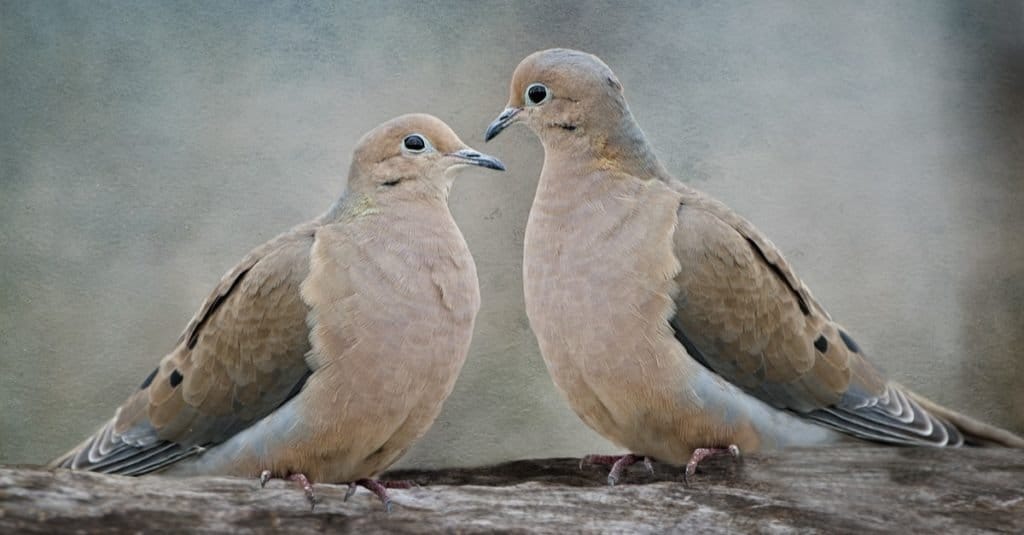Doves are special and adorable soft-looking birds that are fun to play with and often represent world peace and love symbols. While they can delight your mind, their constant cooing and droppings can be frustrating. This is the case with the turtle dove and the mourning dove, who sometimes appear indistinguishable. Nonetheless, we will make the differences between these cousin birds clear in this article, so read on to find out the differences between turtle and mourning doves.
Comparing a Turtle Dove and a Mourning Dove

| Turtle Dove | Mourning Dove | |
|---|---|---|
| Family | Columbidae | Columbidae |
| Size | Length:10–11 in Weight: 0.26875–0.35 lbs Wingspan:19–21.5 in | Length: 8.9 -14.2 inches Weight: 0.28125 – 0.375 lbs Wingspan: 14.6 – 17.7 inches |
| Morphology | Slightly smaller than the mourning dove and has more colorations | Roundhead with tan coloration and bigger compared to the turtle dove. |
| Habitat | Found all over Europe and in areas of Asia, the Mid East, and Africa. | They are mostly found in any open or semi-open habitat in temperate parts of North America, including forest clearings, deserts, suburbs, farmlands, and prairies. |
| Social Behavior | Can live in isolation and in groups. Defends territory during mating season. Mates for life | It can live in isolation and in groups. Defends territory during mating season. Has only one mate throughout its lifetime. |
| Diet | Herbivore | Herbivore |
| Predators | Birds of prey, large mammals, domestic cats, and humans. | Raccoons, hawks, owls, squirrels, snakes, cats, and dogs. |
Key Differences Between a Turtle Dove vs. Mourning Dove
Although it seems like a herculean task to tell the difference between the turtle dove and the mourning dove, it is not an impossible feat to set these two flying creatures apart. While these doves might be confusing to a novice, one can still differentiate them with their size, morphology, appearance, social behavior, and habitat. Nevertheless, they both belong to the Columbidae family, which houses over 300 species of doves and pigeons.
Turtle Dove vs Mourning Dove: Size

Turtle doves have a wingspan of around 19 to 21 inches.
©petritzaa/Shutterstock.com
The turtle dove is 10-11 inches in length, 0.26875–0.35 lbs in weight, and has a wingspan of 19–21 inches. On the other hand, the mourning dove is slightly bigger, having a length of 8.9 -14.2 inches, a weight of 0.28 – 0.38 lbs, and a wingspan of 14.6 – 17.7 inches.
Turtle Dove vs Mourning Dove: Morphology
While the turtle dove and the mourning dove are almost the same size and have similar features, there is still a difference in their morphology. Unlike the mourning dove which has a generic look, the turtle dove has noticeable differences in its more striking and beautiful look. Its wings have a warm cinnamon color and its neck is also marked on the side with black and white stripes. Asides from all these, the face of the turtle dove is rather colorful with bright-orange eyes and blue eyeshadow.
On the other hand, the mourning dove has a brown to tan coloration with black spots on the wings and white edgings in its black tail feathers.
Turtle Dove vs Mourning Dove: Habitat
The turtle dove is a migratory species found in most parts of Europe and Asia, the Middle East, and North Africa. On the other hand, the mourning dove is found mostly in open habitats in temperate parts of North America, including forest clearings, suburbs, prairies, deserts, and farmlands.
Turtle Dove vs Mourning Dove: Social Behavior
Usually, birds within the same family exhibit similar social behavior, and it is no different for the turtle dove and the mourning dove. In fact, these two seem to have very high similarities in social behavior. Both birds can live in groups and do well living a solitary life while also exhibiting territorial characteristics during the mating season.
Turtle Dove vs Mourning Dove: Nest Building
The turtle dove and the mourning dove share similar nest-building instincts. The male from each dove species goes the extra mile to bring the twigs, grasses, pine needles, and other materials used in the nest building while females construct the nest themselves. However, in the mourning dove’s case, the nest-building process takes a unique facet as the female chooses a specific nest site from the numerous ones suggested by the male counterpart.
Turtle Dove vs Mourning Dove: Diet

Mourning doves, as well as turtle doves, eat plants and seeds.
©Bonnie Taylor Barry/Shutterstock.com
Both doves are herbivores and feed on plants and seeds. The diet includes wheat, sunflower, milo, corn, and safflower for the turtle dove. It also consumes the fruits and seeds from plants like spurge, panic grass, bristlegrass, Mexican jumping beans, Chinese tallow, leather weed, saguaro, lime prickly-ash, brazil, privet, pigeonberry, and Ocotillo. On the other hand, the mourning dove eats cultivated grains, peanuts, wild grasses, weeds, herbs, and berries.
Turtle Dove vs Mourning Dove: Predator
Unfortunately, the turtle dove and the mourning dove are not at the top of the food chain, so, by default, they are prey to apex predators. The turtle dove is usually hunted by birds of prey, large mammals, domestic cats, and humans, while the mourning dove, on the other hand, is hunted by raccoons, hawks, owls, squirrels, snakes, cats, and dogs and can be afflicted with several different parasites and diseases, including tapeworms, nematodes, mites, and lice. The mouth-dwelling parasite Trichomonas gallinae is particularly severe.
The photo featured at the top of this post is © Jay Gao/Shutterstock.com
Thank you for reading! Have some feedback for us? Contact the AZ Animals editorial team.






